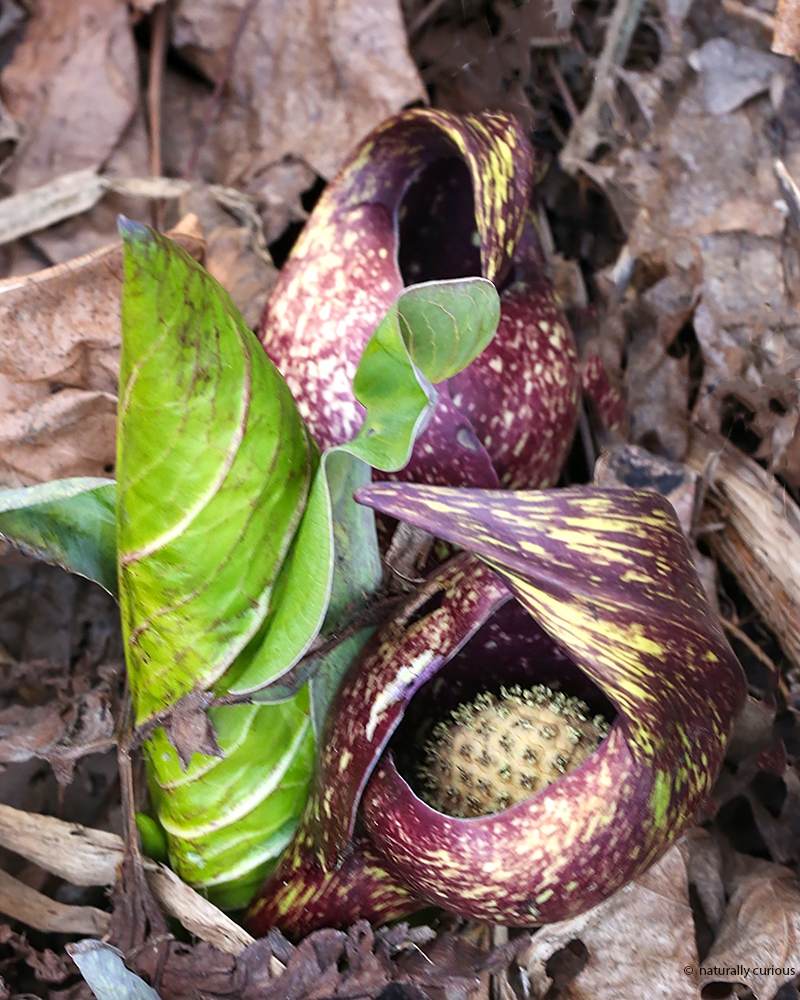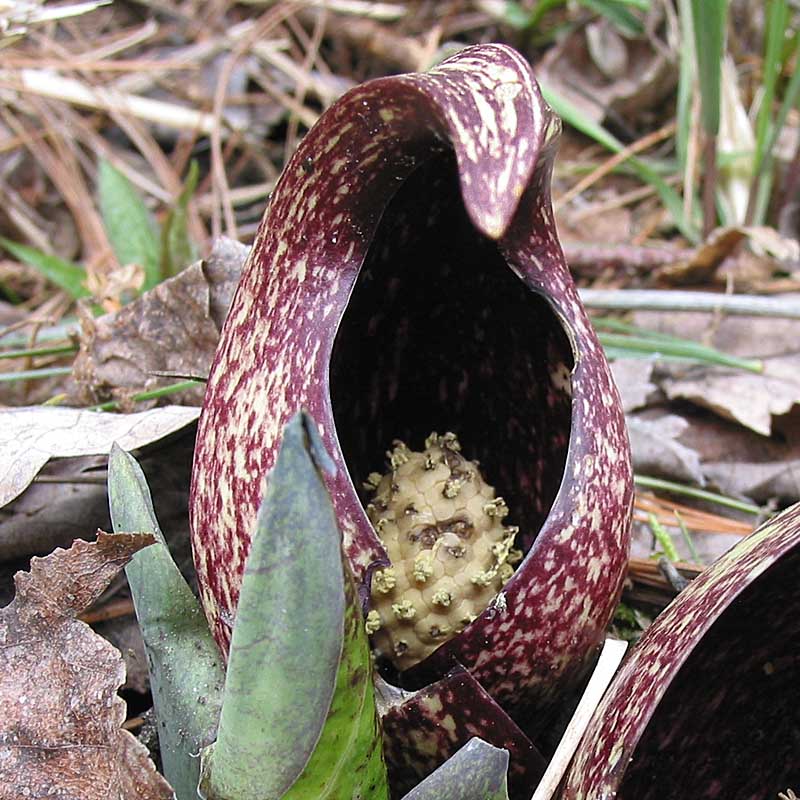Skunk Cabbage’s Heat


A “naturally curious” reader decided to see if she could record the heat that a Skunk Cabbage was producing using an infrared camera on an iphone. The accompanying photographs show the recorded image of heat inside and outside of the plant. Many thanks to Emily Ferguson and David Mueller for enhancing yesterday’s blog post.
Naturally Curious is supported by donations. If you choose to contribute, you may go to http://www.naturallycuriouswithmaryholland.wordpress.com and click on the yellow “donate” button.
Skunk Cabbage Flowering

If you look up, there are numerous trees (poplar, willow, some maples) that have opened their flower buds and are in the midst of being pollinated. However if you look down, the reproduction of forest floor plants has yet to begin except for the early-blossoming Skunk Cabbage (Symplocarpus foetidus). The flowers appear before the leaves and have a mottled maroon hood-like leaf called a spathe, which surrounds a knob-like structure called a spadix. The spadix is actually a fleshy spike of many petal-less flowers. Female flowers form first, followed by male flowers.
Because it can create heat through a process called thermogenesis (one of few flowering plants capable of doing so), Skunk Cabbage can be seen melting its way through several inches of snow. This early maturation benefits the few pollinators such as flies, springtails and beetles that are active now, providing them with both food (pollen) as well as a mini-warming hut for temperatures that are still below freezing some days and nights. (Fueled by energy stored in the plant’s modified underground stem (rhizome), skunk cabbage can maintain temperatures of up to 70° F. within the spathe even as external air temperatures drop below freezing.)
Naturally Curious is supported by donations. If you choose to contribute, you may go to http://www.naturallycuriouswithmaryholland.wordpress.com and click on the yellow “donate” button.
False Hellebore – A Skunk Cabbage Look-alike
 There are two unrelated plants whose very similar leaves are emerging at this time of year in many wetlands. One is Skunk Cabbage (Symplocarpus foetidus), the other False Hellebore (Veratrum viride), also known as Indian Poke. There are foliage differences between these two plants. False Hellebore leaves emerge before its flowers whereas Skunk Cabbage flowers before its leave emerge. In addition, False Hellebore’s leaves clasp the plant’s stem and are elongated and oval, while Skunk Cabbage’s leaves do not clasp the stem and are rounded.
There are two unrelated plants whose very similar leaves are emerging at this time of year in many wetlands. One is Skunk Cabbage (Symplocarpus foetidus), the other False Hellebore (Veratrum viride), also known as Indian Poke. There are foliage differences between these two plants. False Hellebore leaves emerge before its flowers whereas Skunk Cabbage flowers before its leave emerge. In addition, False Hellebore’s leaves clasp the plant’s stem and are elongated and oval, while Skunk Cabbage’s leaves do not clasp the stem and are rounded.
The flowers of these two plants are distinctly different as well. Skunk Cabbage’s yellow, globular flowers are near the ground and have already gone by. In June, False Hellebore produces flowers that are green, star-shaped and borne in large clusters on a tall stalk.
It is not advisable to consume the (raw) leaves of either of these plants. Skunk Cabbage leaves contain calcium oxalate crystals which cause a severe burning sensation in the mouth and the leaves of False Hellebore contain alkaloids which are highly toxic.
Naturally Curious is supported by donations. If you choose to contribute, you may go to http://www.naturallycuriouswithmaryholland.wordpress.com and click on the yellow “donate” button.
Flowering Skunk Cabbage Serves as Warming Hut for Pollinating Insects
 As Skunk Cabbage grows, it absorbs oxygen, and this allows it to produce heat through a process known as thermogenesis. This heat is responsible for the fact that Skunk Cabbage is one of the earliest plants to flower in the spring.
As Skunk Cabbage grows, it absorbs oxygen, and this allows it to produce heat through a process known as thermogenesis. This heat is responsible for the fact that Skunk Cabbage is one of the earliest plants to flower in the spring.
Skunk Cabbage’s flower has two components – the flower-bearing, round spadix and the hood-like spathe that surrounds it. The spadix is able to maintain its temperature at about 68°F., creating a little warming hut inside the spathe for the few insects out this early in the spring. Fueled by the reserved starch in the plant’s underground rhizome, the spadix is able to exceed the temperature outside the spathe by as much as 77°F. for a period of two to three weeks. The combination of the heat produced and the dark, heat-absorbing spathe can cause the snow around the plant to melt. If the ambient temperature drops below 37.4°F., the plant can shut down the heating mechanism until the air temperature rises again. (Thanks to Sadie Brown for photo op.)
Naturally Curious is supported by donations. If you choose to contribute, you may go to http://www.naturallycuriouswithmaryholland.wordpress.com and click on the yellow “donate” button.
Skunk Cabbage Fruits
 After the flowers of Skunk Cabbage, located on the knob (spadix) sitting inside a modified leaf (spathe), have been pollinated and fertilized, the fruits begin to mature. The spathe withers and dies, and the stalk that carries the fruit head elongates, growing along the surface of the ground. Initially the fruit head is green and dark purple, measures 2-3” in diameter, and has a convoluted exterior resembling that of a brain. Inside this compound fruit a circle of 10 to 14 seeds lines the periphery. By August the fruit heads will have fallen apart, and the seeds will lay on the ground where they will likely germinate or be eaten by squirrels, ruffed grouse or wood ducks. (Congratulations Liz, Josh and Deb on correctly identifying yesterday’s Mystery Photo!)
After the flowers of Skunk Cabbage, located on the knob (spadix) sitting inside a modified leaf (spathe), have been pollinated and fertilized, the fruits begin to mature. The spathe withers and dies, and the stalk that carries the fruit head elongates, growing along the surface of the ground. Initially the fruit head is green and dark purple, measures 2-3” in diameter, and has a convoluted exterior resembling that of a brain. Inside this compound fruit a circle of 10 to 14 seeds lines the periphery. By August the fruit heads will have fallen apart, and the seeds will lay on the ground where they will likely germinate or be eaten by squirrels, ruffed grouse or wood ducks. (Congratulations Liz, Josh and Deb on correctly identifying yesterday’s Mystery Photo!)


















What Other Naturally Curious People Are Saying